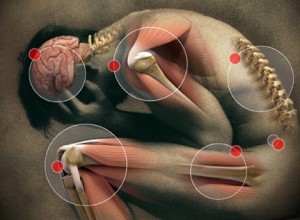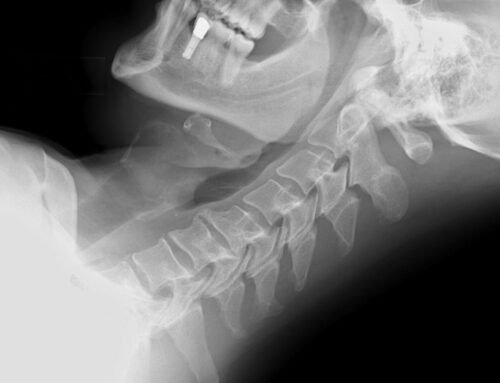I have found after many years of practice that it is not always predictable which clients who have suffered injuries in a car accident will continue to experience pain in the future and sometimes permanently. For many victims pain can last long after an accident. Chronic pain often significantly alters a person’s ability to participate in everyday activities and enjoy their life. Chronic Pain Syndrome includes symptoms of sleep interruption, depression, anxiety, headaches, migraines, etc. There are several types of chronic pain. Somatic pain is pain from the outer body such as the skin and muscles; and visceral pain is pain from the internal organs. This type of pain is easily treated and improves quickly with treatment. Another type of chronic pain is “bone pain”. While bruises and fractures are usually temporary you can have osteoporosis or arthritic disease of the bone which can create chronic pain and difficult to treat. Read the full Emedicinehealth article here.
Chronic pain is pain that persists over a period of six months or longer and typically results from long standing medical conditions or damage to the body. Chronic pain generally prevents a person from engaging in normal activities, causes decreased general strength and negatively affects the quality of a persons’ life. Common sources of chronic pain include personal injuries, headaches, back aches, joint pain due to arthritis, sinus pain, tendonitis, over-use injuries such as carpal tunnel and the like. Chronic pain of course can occur from a number of diseases such as cancer. The emotional side of pain often includes insomnia, depression, mood changes, fatigue, loss of interest, and loss of enjoyment. The goal in treating pain is to diminish or eliminate the pain. Unfortunately many illnesses do not have known cures. In the treatment of these chronic conditions the goal is to diminish and modulate pain so the person may live as normally as possible.
The duration and degree of pain following a physical injury may be unrelated to the severity of the injury. In various studies it has been found that among patients who develop chronic pain a history of relatively minor trauma is common. Chronic pain often involves dysfunctional features not explained by physical pathology. Psycho
Even in cases where litigation has influenced pain behaviors, it should be emphasized that the pain experienced by the litigant is very real, and is experienced as discomfort by the patient in the same way as any other pain. This is true as a “learned behavior syndrome” operates on an unconscious level and is not deliberate. These patients (usually plaintiffs in a personal injury case) do not choose to be in pain no matter what the payoff in terms of psychological or personal benefit. They should therefore be accorded the same attention and medical care as any patient suffering from any other painful condition. There is no proven or comprehensive treatment for any primary care patients with medically unexplained symptoms. The care and treatment must be “tailored” for each individual patient. These include relaxation methods, antidepressants, analgesics and non-steroidal anti-inflammatory drugs, TENS units, physiotherapy, psychotherapy, vocational therapy, and nerve blocks for chronic back and spine pain. Despite the treatment the prognosis invariably for chronic pain treatment is often poor but improvement is possible with suitable support and management. Read More about Chronic Pain Syndrome
The symptoms of chronic pain may be mild to severe and the pain just simply does not go away. Often that pain is described as shooting, burning, achy or electrical. If it is simply a discomfort it’s often described as a soreness, tightness or stiffness. Pain is not a symptom that exists alone. Other problems are generally associated with pain including fatigue, sleeplessness, withdrawal from activity, an increased need to sleep, weak immune system, mood changes including hopelessness, fear, depression, irritability, anxiety and stress.
Once you’ve suffered a personal injury and go to your doctor there are various techniques he will use to determine the cause of the pain including pain measurement tools and X-ray devices. CAT scans and MRIs are often used to create pictures of the body to determine the source of the problem. Discography may also be used during which a contrast dye is injected in the spinal disc that is thought to be causing back pain. The dye will outline the damaged area on X-rays. This procedure is often suggested for people who are considering surgery or interdiscal electrothermal treatment. Myelograms similar to discography produce a view of the spine using a contrast dye injected into the spinal canal. Often an X-ray then taken can be identify an area where a nerve is compressed caused by a herniated disc or a fracture. EMGs may be used to allow doctors to evaluate the activity of the muscles. The very fine needles are inserted into muscles and measure the muscle’s response to signals from the brain or the spinal cord. Bone scans are often done to diagnose fractures or other disorders of the bone. During a bone scan a small amount of radioactive material is injected in the blood stream, and this will collect in the bone and areas of abnormality may be diagnosed. Ultrasound imaging is a test where the doctor uses high frequency sound waves to obtain images inside the body. 
According to the Institute of Medicine of the National Academies, and estimated 116,000,000 experience chronic pain and is costing the United States up to $635,000,000,000 annually. The Institute’s report entitled “Relieving Pain in America: A Blueprint for Transforming Prevention, Care, Education and Research” states that our healthcare system has largely failed us for approaches and management for patients with pain. Dr. Phillip A. Pizo, Dean of Pediatrics at Stanford University, states that prevention and treatment of pain are too often “delayed, inaccessible or inadequate”, especially among “racial and ethnic minorities, women and children and those of lower income and education”. A lot of his patients indicate that medical providers often tell them they are simply “faking”. His conclusion is that chronic pain is not in your head, it’s a disease in its own right and so management and prevention of pain requires an innovative approach that responds to all factors that influence pain. The National Institute of Health has been requested to create a large population based public health strategy to deal with pain management, including better education to healthcare providers. As Pizo says, to be blunt “doctors need to develop some skills they lost along the way”. ABC News Article
If you are suffering from chronic pain syndrome as the result of an vehicular accident, fall or other accident where another party is at fault, and need to speak with an experienced Indiana personal injury attorney, call William (“Bill”) Hurst toll free 1-800-636-0808 for a free consultation. You may also read about our law firm at www.https://hurstlimontes.com/m and contact us by e-mail. We represent personal injury victims throughout the Midwest and we only charge a fee if you get paid.







